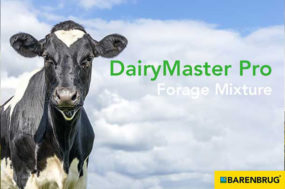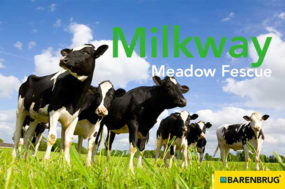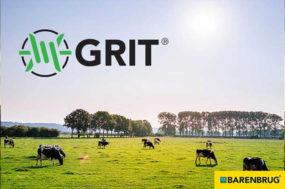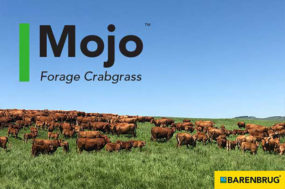It also distorts comparisons between different forage types. In fact, RFV is kind of like that old barn on our farm. We know the barn has problems – the roof leaks, the pillars are badly placed, the alleyways are too narrow – but we continue to use it anyway because ... well, because we’re used to it, and it would take a lot of effort to replace it.
But with RFV, scientists have made a solid effort to design a new barn – uh, forage score – that is indeed superior. It’s called relative forage quality (RFQ).
The primary movers behind RFQ are Dan Undersander, a forage specialist from Wisconsin, and John Moore, a nutritionist from Florida. When they first published their proposal in 2002, their choice of the words “forage” and “quality” were not an accident; they were seeking precision.
The words in the name “relative feed value” are ambiguous. What kind of feed? Hay? Corn? Dried apricots? And does the word “value” refer to nutritional value or price value? In contrast, the name “relative forage quality” is precise. It’s definitely about forages and nutritional quality.
But these scientists were also realists. They wanted acceptance. They knew that if their new RFQ scoring system was too different from the old RFV scores, most folks would refuse to switch because – well, it wasn’t what they were used to. People don’t change just because “something is good for them.”
At least not in my world. So these researchers carefully fashioned the RFQ system to resemble RFV. Which means that most RFQ scores fall in a similar range of 70 to 200.
And that the reference score of 100 was still based on the same full-bloom alfalfa hay containing 53 percent NDF and 41 percent ADF. (These fiber values are listed in all modern forage quality reports: NDF = neutral detergent fiber, ADF = acid detergent fiber.) All this to make it easier for folks to slide into using RFQ without much concern. Good thinking.
Breaking down the equation concepts
Now, let’s look under the RFQ hood. Like its predecessor, RFQ is calculated from an equation that incorporates two main ideas: forage intake and forage digestibility. Basically, RFQ is a single number that combines the two concepts of (1) how much forage will the animal consume, expressed as dry matter intake (DMI) and (2) the nutritional value of that forage, expressed as total digestible nutrients (TDN). Each of these terms is derived from a specific equation.
As in the previous article discussing RFV limitations (June issue of Progressive Forage), I won’t go into the grueling mathematical details of these equations. I’ll just list the critical concepts to give you the broad overview. This also makes for easier reading. But do prepare yourself for a lot of acronyms. It’s the nature of this beast.
The first thing we notice is that RFQ is calculated by two different sets of equations: one set for legumes and one set for grasses. This is a great start, because it’s clear that RFQ recognizes the reality that for forages, one size doesn’t fit all.
For legumes like alfalfa, the clovers, the trefoils, etc., and also for legume-grass mixtures, the DMI term is calculated from an equation containing the percent NDF in the forage and also an adjustment factor for the digestibility of that NDF. Lab technicians determine NDF digestibility by allowing the fiber to ferment in a small beaker for 48 hours under strictly controlled conditions.
The amount of fiber that disappears during this fermentation period represents the digestibility of that fiber. Although this procedure entails some extra laboratory work and time, it gives a reasonable estimate of what happens to fiber in the rumen. The old RFV equation simply ignored this concept.
The legume TDN equation is rather complex. It includes five terms: (1) crude protein, (2) fat, (3) non-fiber carbohydrates (NFC), (4) nitrogen-free NDF (NDFn) and (5) NDF digestibility. “Non-fiber carbohydrates” represents starches and soluble sugars.
“Nitrogen-free NDF” is the NDF value minus any nitrogen that may be caught up in the fiber. This term is included in the TDN equation to avoid counting the same nitrogen twice (i.e., once in the protein term and once in the fiber term).
Finally, the RFQ score for a legume forage is then calculated by adding the results of its legume DMI equation and its legume TDN equation.
Grasses, however, are very different. Grasses generally contain more fiber than legumes, and grass fiber tends to be more digestible than legume fiber. Also, the mathematical predictions with grasses are more complex than with legumes, as you’ll see.
For grasses, the DMI term is estimated with an equation that contains crude protein, TDN and ADF. These terms actually appear twice in the equation, with the second time being squared (multiplied by itself). You remember squares and square roots from high school, don’t you?
Anyway, this complexity is necessary because in grasses, unlike legumes, the prediction relationship between grass DMI and these terms is not a straight line. In the parlance of statisticians, this relationship is curvilinear, which is a fancy way of saying that it is not a straight line. Mathematically, scientists shape this prediction line into an appropriate curve by including squared terms in the equation.
The grass DMI equation also contains an unusual term that is the product of multiplying ADF by crude protein. This term reflects the complex interactions between the types of fiber in ADF (lignin and cellulose) and nitrogen.
Which also suggests that even if these interactions exist in legumes, they are not large enough to affect the DMI of legumes and therefore are not included in the legume DMI equation.
Unlike the equation for grass DMI, the grass TDN equation is straightforward. It includes the same terms found in the legume TDN equation, although the coefficients are different.
Finally, the RFQ score for a grass forage is then calculated by adding the results of its grass DMI equation and its grass TDN equation.
Still with me? I know this sounds like taking the square root of your birthday and multiplying it by the score of the sixth game of last year’s World Series, but please hang in there for a bit longer ...
For those of you with nutritional training, you may have asked an obvious question about fats, since the TDN equations include a term for fat. Do these equations adjust for the higher level of energy in fats? Well, you can rest easy. Each TDN equation indeed multiplies the fat term by 2.25 to account for its extra energy. Just like in the textbooks.
Why we need RFQ
But now the real question: With all these acronyms and arithmetic gobbledygook, is RFQ a true improvement over RFV? The straightforward answer is yes.
Why? In short, because RFQ successfully reflects the reality of the complex interactions among the forage nutrients. In the brief period RFQ has been available, laboratories comparing RFQ and RFV have consistently observed improved predictions with RFQ.
High-quality grasses showed RFQs that were indeed higher than RFVs, sometimes by more than 20 points. RFQ is very sensitive to different types of fibers and different levels of fiber digestibility. It picks up differences between leaves and stems – just as it was designed.
And heat damage, which reduces forage digestibility, concomitantly reduces the RFQ value, while it has no effect on RFV. These are all practical field situations, and RFQ seems to reflect those situations and perform as designed.
RFQ, however, still has some shortcomings. Although it nicely differentiates between legumes and grasses, it doesn’t differentiate within those categories. Warm-season grasses differ from cool-season grasses in their fiber and protein characteristics.
Temperate legumes differ from warm-season legumes such as lespedeza and lablab. And even corn silage may cause prediction problems because of the varying digestibilities of starch among different corn varieties. RFQ may need additional equations to account for these categories.
Also, farmers and ranchers are routinely using alternative forages like chicory, plantain and forage brassicas. Where do these fit into the RFQ equations? Right now, nowhere.
RFQ was not designed for these forages. (Interestingly, feed testing labs will cheerfully list RFV or RFQ scores in their reports for any forage samples submitted to them.) I see lots of opportunities for graduate student research in the next few years.
But why end there? What about farmers who routinely make hay from weeds – thistle, blackberry, nightshade, hemlock? Perhaps we could devise a score called “relative forage poisonality” (RFP). Then, by using an equation that combines RFP with RFQ, we could really claim to know our Ps and Qs. ![]()
PHOTO: Round bales in the hay field. Photo by Lynn Jaynes.
Woody Lane, Ph.D., is a livestock nutritionist and forage specialist in Roseburg, Oregon. He operates an independent consulting business and teaches workshops across the U.S. and Canada. His book, From The Feed Trough: Essays and Insights on Livestock Nutrition in a Complex World, is available through Woody Lane.

-
Woody Lane, Ph.D.
- Lane Livestock Services
- Roseburg, Oregon
- Email Woody Lane, Ph.D












